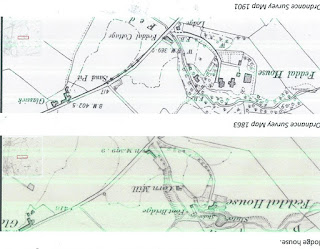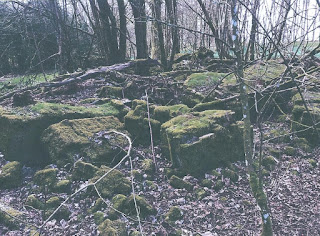Feddal Castle, Braco
Feddal Castle, Braco
Introduction
: The PerthshireCrieffStrathearn
Blogs have been posting
now on local history and places of interest in the area for over
10 years with well over 200 tales
of varying styles and types . This
new blog on Feddal Castle at Braco is
of special interest to me . It is
the first blog by
my son Nic and his family . A team effort if there ever was one ! The buildings have a fascinating history and have been comparatively neglected
by other local historians despite
its proximity to Braco and ease of access . The standard of pictures throughout
is high and the script informative ;
Blog Team
: Nic Mayall
,Caroline Mayall and Callum Mayall
As a relative newcomer to Braco &
Greenloaning, I am keen to explore some of the local history and learn more
about the area.
Braco is rich in history, being home
to one of the best preserved Roman camps at Ardoch and also Braco Castle. My curiosity
has been piqued more about the history we can’t see and, in particular, the two
local mansions that have now been demolished – Ardoch House and Feddal Castle.
There has been quite a lot written
about Ardoch House already so my initial research has focussed on learning more
about the curious Feddal Castle.



The site of the former Feddal Castle
is about 1 mile west of the village of Braco, just off the Feddal Road (B8033).
There are a number of houses/cottages at the foot of the old drive including
the former lodge house.

Ordnance Survey Map 1863

Ordnance Survey Map 1901
Some confusion exists between Feddal House and Feddal Castle.
The Ordnance survey map of 1863 shows the original Feddal House. The 1901
Ordnance survey map shows the location of the new, grander baronial style
Feddal Castle, built in 1900.
Feddal House
The former, the original Feddal House, still exists, albeit
now as a rather sad ruin. Feddal House was built in 1683 as the ancestral seat
of the Burden family.
The Burdens were a sept of the Clan Lamont, which,
somewhat coincidentally, is also my own clan on my father’s side.
The Burdens first established themselves in the Barony of
Easter Feddal in 1623 and by 1683 had a finely built baronial great house –
Feddal House. There is a stone dating the badly ruined house from that time
with interlocking mirror image B’s.
The 1683 inscription with the Burden Bs.
One of the earlier inhabitants of Feddal House was James
Burden, Laird of Feddal, who enaged in a famous duel with the Laird of
Balhaldie in the early 1700’s. After an hour of hacking and slashing, neither
had gained an advantage until the sword of James broke off at the hilt. Instead
of pressing his advantage, the Laird of Balhaldie (also the clan chief of the
MacGregors) nobly threw down his sword and the two became firm friends.
This is an extract of these events as
cited in “Dunblane Traditions” published in 1835:
“In the Laird’s younger years a feud
existed between himself and a neighbouring proprietor—the Laird of Feddal .
This Feddal was reported the ne plus ultra of the district in the management of
the Highland broad sword, so dexterously adept that he could measure his
distance -point in a manner so very exact as to cut the button from the shirt neck
of an antagonist without injuring his person. Baldhaldie could ill brook the
idea being entertained that a better man existed than himself at the broadsword
. It was his favourite weapon of war—he practised it from childhood, and never had
in bloody strife met his equal . In order, as he said, to settle differences
for ever, then existing between himself and the Laird of Feddal, he challenged
the Laird to single combat—sword and targe . The challenge being accepted , the
parties met on the banks of the Allan , below Greenloaning , when a desperate
combat ensued, which continued upwards of an hour. The combatants by this time
were both slightly wounded, but neither seemed to have the least advantage of
his antagonist—only Balhaldie, being the stronger man, was expected to hold
longest out. At this critical moment the false blade of Feddal gave way at the
hilt, and he, expecting to be instantly stabbed to the heart, sprang back, and
bared his breast to the foe. But Balhaldie was as generous as he was brave ;
and respecting, to a high degree of enthusiasm, all whom he found adepts in the
use of his favourite weapon, instantly checked himself, and casting his sword
and targe to the ground, threw his arms around the man with whom he had just been
engaged in deadly strife, and, warmly embracing him, begged that henceforth
they might be friends . He at the same time declared that all he had heard of
his opponent’s prowess must be true , since his own life was never till that
moment in danger. Feddal returned a similar compliment to the dexterity of
Balhaldie ’ s sword - arm, and from that moment the rival sword players,
instead of being jealous and inveterate enemies, became united in the bonds of
indissoluble friendship.”
Feddal House’s other significant claim to fame is that the
young pretender, Bonnie Prince Charlie, stayed there. Below are a number of
photos I took on a walk through the Feddal estate in April 2020. The original
Feddal House, whilst long since deserted, is in a reasonable state of
preservation. The stone entrance gate appears to be a later edition to the main
house and may have been added as a grand entrance to the new Feddal Castle.
 |
 |




















.jpg)
Braco, birthplace of William McGregor (13 April 1846 - 20 December 1911) was an association football administrator in the Victorian era who is regarded as the founder of the Football League, the first organised association football league in the world.
ReplyDelete